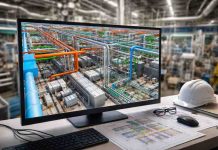Remote work has shifted from a temporary solution to a permanent reality for tech professionals. Your home hardware setup directly impacts code quality, debugging speed, and career longevity. Many developers optimize their software stack while neglecting physical infrastructure. This guide covers essential hardware that forms the foundation of productive remote work, focusing on equipment that delivers measurable returns through reduced fatigue and increased output.
Key Takeaways
- Remote work demands a solid hardware setup for better productivity; this includes display technology, input devices, computing power, and network infrastructure.
- Choose monitors with higher resolution, like 1440p, for coding while considering ergonomics, like screen height and distance.
- Mechanical keyboards and quality mice enhance comfort during long coding sessions, while good webcams and microphones improve professionalism in remote interactions.
- Invest in quality seating and workspace ergonomics to maintain comfort and focus, as these factors directly affect productivity.
- Use power management solutions like UPS units, and ensure your overall setup evolves to meet your changing work needs.
Table of Contents
Display Technology
Your monitor choice affects how quickly you spot bugs and how much context you can maintain while switching between code, documentation, and terminal windows. Resolution matters significantly: 1440p provides the sweet spot for most development work, offering crisp text without the GPU demands of 4K. However, frontend developers and designers benefit from 4K panels when working with high-density graphics.
Panel technology presents real tradeoffs. IPS displays deliver superior color accuracy, critical for anyone touching visual design. VA panels offer better contrast ratios, making text pop against dark IDE themes during late-night debugging sessions. Refresh rates matter less for coding than gaming, but a 75Hz minimum reduces eye strain during long sessions compared to standard 60Hz displays.
The ultrawide versus dual monitor debate depends on your workflow. Ultrawide screens eliminate the bezel interruption and simplify window management, while dual monitors provide cleaner separation between primary coding and reference materials. Consider a vertical monitor as a third display for reading logs, reviewing pull requests, or monitoring long files.
VESA mounting liberates valuable desk space and enables precise positioning. Color calibration tools justify their cost for frontend work where accurate color representation affects production output. Blue light filtering helps during evening work, though software solutions like f.lux often work as well as hardware filters at zero cost.
Cable management deserves attention beyond aesthetics. Properly routed cables in your hardware setup prevent accidental disconnections during critical deployments or client calls. Velcro straps and cable raceways create systems that accommodate future changes without requiring a complete teardown.
Input Devices and Peripherals
Mechanical keyboards impact typing fatigue during marathon coding sessions. Tactile switches like Cherry MX Browns provide feedback without the noise of clicky Blues, while linear Reds suit developers who prefer smooth keystrokes. Switch selection matters more than brand, though build quality varies significantly across manufacturers.
Wireless technology has matured enough for production work, but wired connections eliminate the mental overhead of battery monitoring. Programmable macro keys accelerate repetitive tasks, from boilerplate code insertion to complex terminal commands. Your keyboard represents your primary interface with your craft, so spending on quality returns dividends.
Mouse considerations are split between precision and comfort. Frontend developers need pixel-perfect accuracy for layout work, while backend engineers prioritize comfortable navigation through large codebases. Trackballs present viable alternatives for those experiencing repetitive strain, though they require adaptation time.
Quality webcams matter more than most developers initially assume. Your video presence during standups and pair programming sessions affects team perception of your engagement and professionalism. Microphone technology deserves equal attention. USB condenser microphones deliver clear audio for most situations, while XLR setups with audio interfaces provide broadcast-quality sound for those hosting technical talks or recording content.
Headphone selection balances comfort with audio isolation. Open-back designs prevent ear fatigue during all-day wear but leak sound into your environment. Closed-back models isolate you from household noise while containing your audio, preventing distraction for others sharing your space.
Computing Power and Network Infrastructure
Desktop versus laptop tradeoffs extend beyond portability. Desktops offer superior performance per dollar and easier upgrades, while laptops provide flexibility for location changes and built-in backup during power issues. Many remote developers run both hardware setups: a desktop as a primary workhorse, a laptop for meetings and travel.
RAM requirements scale with your stack. 16GB suffices for basic web development, 32GB handles containerized development comfortably, and machine learning workflows demand 64GB or more. SSD technology affects compilation times and virtual machine performance significantly. NVMe drives deliver noticeably faster build cycles compared to SATA SSDs, particularly for large projects.
CPU selection balances core count against clock speed. Highly parallel workloads like compilation benefit from more cores, while single-threaded tasks respond to higher frequencies. GPU considerations extend beyond gaming when your work includes CUDA-accelerated machine learning training or graphics rendering.
Network hardware receives insufficient attention from developers focused on code. Router quality affects SSH responsiveness and video call stability. Mesh systems solve coverage problems in larger homes, though traditional routers with access points often deliver better performance. Wired Ethernet connections provide stability for production deployments and eliminate wireless interference variables.
Backup internet solutions protect against outages during critical deadlines. Mobile hotspots serve as an adequate failover for most situations. UPS systems prevent data loss during power interruptions and provide clean shutdowns when outages extend beyond battery capacity. NAS devices enable local backups without cloud service monthly costs while doubling as media servers.
Workspace Ergonomics and Physical Hardware Setup
Desk height calculations start with your elbow angle when typing. Arms should rest at roughly 90 degrees with shoulders relaxed. Screen distance follows the arm’s length rule, with the top of the display at or slightly below eye level to prevent neck strain.
Room lighting prevents glare and reduces eye fatigue. Position monitors perpendicular to windows when possible, avoiding direct sunlight on screens. Task lighting for evening work allows productivity without flooding the room with light that disturbs others in your household.
Acoustic treatment improves audio quality in video calls. Simple foam panels reduce echo and make your voice clearer to remote colleagues. Temperature control impacts concentration more than most realize. Maintaining 20 to 22 degrees Celsius optimizes cognitive performance according to research on workplace productivity.
Air quality monitors reveal issues in sealed home office spaces. Purifiers address particulate concerns while providing white noise that masks household sounds. Cable management creates visual calm that supports focus, while preventing accidental disconnections during critical work.
Proper seating forms the foundation of sustainable remote work. Hours spent debugging complex issues require support that maintains focus rather than creating distractions through discomfort. Adjustable features allow position changes throughout the day to prevent stiffness. Lumbar support mechanisms should adjust to individual spine curvature rather than providing generic support curves.
Armrest positioning affects shoulder tension during keyboard and mouse use. Fixed armrests often create problems rather than solving them. Seat depth adjustment accommodates different leg lengths, preventing circulation issues and nerve compression. Breathable materials prevent overheating during New Zealand summers when home offices lack the climate control of commercial buildings.
Investment in seating quality pays returns through sustained productivity across years of use. Quality office chairs designed for extended sitting exist across budget ranges for remote workers at different career stages.
Power Management and Backup Systems
Surge protectors provide minimal protection compared to UPS units. Battery capacity calculations should account for your specific hardware load plus a 30% margin. Pure sine wave UPS units cost more but protect sensitive electronics better than simulated sine wave alternatives.
Automatic shutdown scripts enable graceful handling of power loss, closing applications and saving state before battery depletion. Smart plugs enable scheduled equipment power cycling, useful for routers and network equipment that benefit from periodic reboots.
Power consumption monitoring supports accurate home office tax deductions in New Zealand, where remote workers can claim proportional electricity costs. Energy efficiency impacts both monthly bills and environmental footprint, factors that compound over years of remote work.
Building Your Hardware Setup
Initial setup costs feel substantial but amortize across years of daily use. Incremental upgrades allow spreading investment over time based on priority. Your setup directly competes with office environments when employers evaluate remote work viability. Professional equipment signals commitment to craft during video calls with clients and team members.
Physical comfort enables the mental clarity required for solving complex technical problems. Regular reassessment of your hardware setup ensures your workspace evolves with changing project needs and emerging technology. Remote work success depends equally on technical skills and physical infrastructure supporting those skills.











